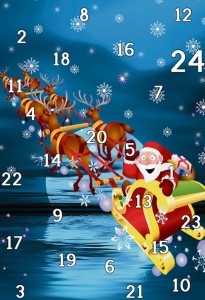Advent season begins Nov. 30 and continues for four weeks until Christmas. The word Advent comes from the Latin verb “advenare,” which means “to arrive” and indicates the coming of Christ.
Germans observe numerous traditions during Advent. Lighting candles on the Advent wreath is one of them. The first candle is lit the fourth Sunday before Christmas, which is Nov. 30. The original Advent wreath is made of fir tree branches decorated with four candles, fir cones, ribbons and little Christmas ornaments. Today, Advent wreaths of different shapes are made of different materials and placed in homes, stores, offices, public buildings and churches.
The history of the Advent wreath goes back to northern Germany in 1839, when Johann Hinrich Wichern, the founder of the

Advent calendars help count down the days until Christmas. Children open the first door Dec. 1.
Evangelist Home Mission and a juvenile home, created the first wreath made of wood and decorated with 24 candles — four big white ones for Sundays and little red ones to be lit on weekdays.
Also visible in windows during this season are wooden arches with candles. They originate in the Erzgebirge mountains, where in the 17th century miners started to create these items after working in dark mines for many years.
Another tradition observed by children is the Advent calendar. Starting Dec. 1, children open a door on the calendar each day until Christmas Eve, when traditionally German children receive their gifts.
The history of the Advent calendar is more than 100 years old. It was invented by a mother in Munich, whose son Gerhard, as soon as the first candle of the Advent wreath was lit, kept asking when Santa Claus would come and bring the gifts.
Gerhard Lang’s mother had to think of something to make him understand when the waiting time was over. She designed a cardboard box on which she drew 24 squares.
She explained to little Gerhard that each square meant getting up once and going to bed again. She even sewed a cookie onto each square to sweeten up the waiting time. From then on, Gerhard’s mother had to design a calendar every year until she thought he was too old for it.
At the turn of the century, Gerhard Lang founded, together with a partner, a lithographic art publishing company.
When business wasn’t good anymore, he remembered his mother’s idea and brought the “Munich Christmas calendar” onto the market in 1904. Its subtitle was “The 24 Waiting Days,” and it was sold for 30 pfennigs (about 15 euro cents) in stationary shops.
Today, different kinds of Advent calendars are available — cardboard calendars, felt calendars with filled pockets, 24 bags hung up on a string or 24 little houses set up like a town.
The baking of Christmas cookies is another tradition during Advent. There is a large variety — cookies with nuts, almonds, chocolate, marmalade, nougat, vanilla or marzipan. Traditional butter cookies are made in the shape of Christmas motifs such as stars, Christmas trees, candles, bells and snowmen.
Other baked goods only offered during pre-Christmas time are Dresdner Stollen, a cake filled with raisins, candied lemon peel
and orange peel, and gingerbread, or “Lebkuchen,” which is known all over the world.


